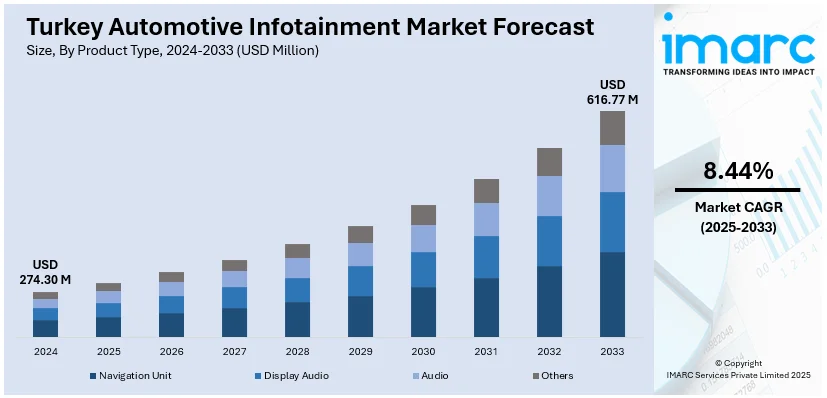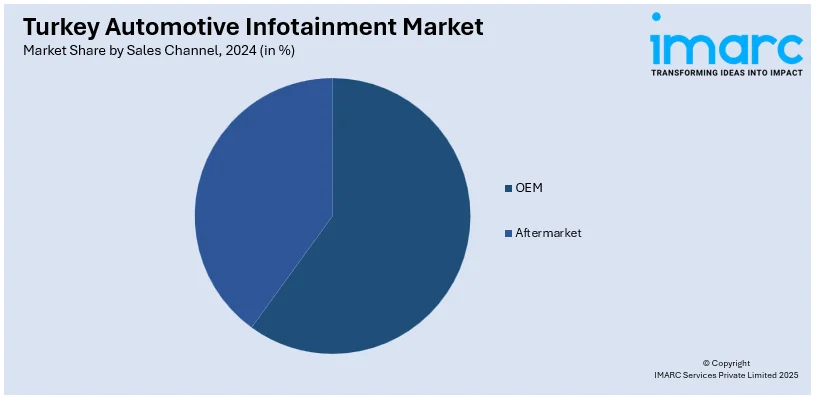
Turkey Automotive Infotainment Market Size, Share, Trends and Forecast by Product Type, Vehicle Type, Operating System, Installation Type, Sales Channel, Technology, Connectivity, and Region, 2025-2033
Turkey Automotive Infotainment Market Overview:
The Turkey automotive infotainment market size reached USD 274.30 Million in 2024. Looking forward, IMARC Group expects the market to reach USD 616.77 Million by 2033, exhibiting a growth rate (CAGR) of 8.44% during 2025-2033. At present, people increasingly expect connected cars featuring sophisticated digital capabilities. Moreover, the industry is being heavily impacted by carmakers who are constantly installing cutting-edge technologies into their vehicles. Furthermore, government plans and industry trends for smart mobility solutions are further expanding the Turkey automotive infotainment market share.
|
Report Attribute
|
Key Statistics
|
|---|---|
|
Base Year
|
2024
|
|
Forecast Years
|
2025-2033
|
|
Historical Years
|
2019-2024
|
| Market Size in 2024 | USD 274.30 Million |
| Market Forecast in 2033 | USD 616.77 Million |
| Market Growth Rate 2025-2033 | 8.44% |
Turkey Automotive Infotainment Market Trends:
Increasing Consumer Demand for Connected Vehicles
The automotive infotainment sector in Turkey is witnessing robust momentum as people increasingly expect connected cars featuring sophisticated digital capabilities. People are expecting greater value for in-car connectivity, easy smartphone integration, and real-time navigation systems that improve convenience and driving experience. Infotainment systems are no longer being used as a luxury feature. They are preferred by customers as a standard feature across various vehicle segments. People are interested in entertainment solutions, voice-command features, and internet-connected platforms that provide constant access to digital services. Younger audience segments, specifically, are emphasizing interactive touchscreens, app-based services, and personalized entertainment choices while making buying decisions. While automotive brands are growing their product lines with improved infotainment packages, the value of the vehicle is linked to integration with technology. This continuous trend is having a decisive impact in driving the introduction of infotainment systems in passenger cars and premium automobile segments in Turkey. In 2025, Türkiye's national automobile manufacturer Togg, established under President Recep Tayyip Erdoğan's guidance in June 2018, is set to introduce its second electric model, the T10F, this summer, two years post the launch of its initial smart vehicle, the T10X. The T10F, crafted as a sportier option compared to the T10X, is anticipated to provide a range of up to 600 kilometers (372.82 miles), roughly 80 kilometers more than its SUV equivalent. It includes sophisticated driver-support systems and integrated artificial intelligence.

To get more information on this market, Request Sample
Rising Integration of Sophisticated Technologies by Automakers
The Turkish automobile infotainment industry is being heavily impacted by carmakers who are constantly installing cutting-edge technologies into their vehicles. Automakers are adding innovations like artificial intelligence (AI), cloud-platforms, and Internet of Things (IoT) connectivity to make their products stand out in a competitive environment. Infotainment systems are being crafted with better user interfaces, real-time traffic information, predictive navigation, and voice-activated features, thus revolutionizing the driving experience. Automakers are also partnering with technology firms to introduce sophisticated audio-visual features, over-the-air updates, and smartphone mirroring abilities in mass market models. This integration of technology is not only enhancing the convenience of the driver but also placing infotainment systems at the very core of vehicle safety and operational efficiency.
Increasing Government and Industry Drive for Intelligent Mobility
Government plans and industry trends for smart mobility solutions are further fueling the growth of Turkey automotive infotainment market growth. Governments are facilitating digitalization in the transportation sector via policies that stimulate innovation as well as intelligent infrastructure construction. Such a setting is offering automakers and suppliers the prospect to embed smart infotainment solutions into vehicles that fit within wider objectives of connected mobility. Industry players are interested in connected car ecosystems, vehicle-to-infrastructure (V2I) communications, and real-time telematics that are all dependent on infotainment platforms. As Turkey seeks to be a regional leader in advanced automotive production, funds are being allocated to smart vehicle technologies. In light of the trends in mobility tilting toward connected, autonomous, and electrified cars, infotainment systems are becoming instrumental in facilitating fluid user experiences. This coordination of public support and business approach is constantly inducing the take-up of infotainment solutions throughout the Turkish automotive industry. IMARC Group predicts that the Turkey automotive market is projected to attain USD 43.2 Billion by 2033.
Turkey Automotive Infotainment Market Segmentation:
IMARC Group provides an analysis of the key trends in each segment of the market, along with forecasts at the country and regional levels for 2025-2033. Our report has categorized the market based on product type, vehicle type, operating system, installation type, sales channel, technology, and connectivity.
Product Type Insights:
- Navigation Unit
- Display Audio
- Audio
- Others
The report has provided a detailed breakup and analysis of the market based on the product type. This includes navigation unit, display audio, audio, and others.
Vehicle Type Insights:
- Passenger Cars
- Commercial Vehicles
A detailed breakup and analysis of the market based on the vehicle type have also been provided in the report. This includes passenger cars and commercial vehicles.
Operating System Insights:
- QNX
- LINUX
- Microsoft
- Others
The report has provided a detailed breakup and analysis of the market based on the operating system. This includes QNX, LINUX, Microsoft, and others.
Installation Type Insights:
- In-Dash Infotainment
- Rear Seat Infotainment
A detailed breakup and analysis of the market based on the installation type have also been provided in the report. This includes in-dash infotainment and rear seat infotainment.
Sales Channel Insights:

- OEM
- Aftermarket
The report has provided a detailed breakup and analysis of the market based on the sales channel. This includes OEM and aftermarket.
Technology Insights:
- Integrated
- Embedded
- Tethered
A detailed breakup and analysis of the market based on the technology have also been provided in the report. This includes integrated, embedded, and tethered.
Connectivity Insights:
- Bluetooth
- Wi-Fi
- 3G
- 4G
- 5G
The report has provided a detailed breakup and analysis of the market based on the connectivity. This includes Bluetooth, wi-fi, 3G, 4G, and 5G.
Regional Insights:
- Marmara
- Central Anatolia
- Mediterranean
- Aegean
- Southeastern Anatolia
- Black Sea
- Eastern Anatolia
The report has also provided a comprehensive analysis of all the major regional markets, which include Marmara, Central Anatolia, Mediterranean, Aegean, Southeastern Anatolia, Black Sea, and Eastern Anatolia.
Competitive Landscape:
The market research report has also provided a comprehensive analysis of the competitive landscape. Competitive analysis such as market structure, key player positioning, top winning strategies, competitive dashboard, and company evaluation quadrant has been covered in the report. Also, detailed profiles of all major companies have been provided.
Turkey Automotive Infotainment Market Report Coverage:
| Report Features | Details |
|---|---|
| Base Year of the Analysis | 2024 |
| Historical Period | 2019-2024 |
| Forecast Period | 2025-2033 |
| Units | Million USD |
| Scope of the Report |
Exploration of Historical Trends and Market Outlook, Industry Catalysts and Challenges, Segment-Wise Historical and Future Market Assessment:
|
| Product Types Covered | Navigation Unit, Display Audio, Audio, Others |
| Vehicle Types Covered | Passenger Cars, Commercial Vehicles |
| Operating Systems Covered | QNX, LINUX, Microsoft, Others |
| Installation Types Covered | In-Dash Infotainment, Rear Seat Infotainment |
| Sales Channels Covered | OEM, aftermarket |
| Technologies Covered | Integrated, Embedded, Tethered |
| Connectivities Covered | Bluetooth, Wi-Fi, 3G, 4G, 5G |
| Regions Covered | Marmara, Central Anatolia, Mediterranean, Aegean, Southeastern Anatolia, Black Sea, Eastern Anatolia |
| Customization Scope | 10% Free Customization |
| Post-Sale Analyst Support | 10-12 Weeks |
| Delivery Format | PDF and Excel through Email (We can also provide the editable version of the report in PPT/Word format on special request) |
Key Questions Answered in This Report:
- How has the Turkey automotive infotainment market performed so far and how will it perform in the coming years?
- What is the breakup of the Turkey automotive infotainment market on the basis of product type?
- What is the breakup of the Turkey automotive infotainment market on the basis of vehicle type?
- What is the breakup of the Turkey automotive infotainment market on the basis of operating system?
- What is the breakup of the Turkey automotive infotainment market on the basis of installation type?
- What is the breakup of the Turkey automotive infotainment market on the basis of sales channel?
- What is the breakup of the Turkey automotive infotainment market on the basis of technology?
- What is the breakup of the Turkey automotive infotainment market on the basis of connectivity?
- What is the breakup of the Turkey automotive infotainment market on the basis of region?
- What are the various stages in the value chain of the Turkey automotive infotainment market?
- What are the key driving factors and challenges in the Turkey automotive infotainment market?
- What is the structure of the Turkey automotive infotainment market and who are the key players?
- What is the degree of competition in the Turkey automotive infotainment market?
Key Benefits for Stakeholders:
- IMARC’s industry report offers a comprehensive quantitative analysis of various market segments, historical and current market trends, market forecasts, and dynamics of the Turkey automotive infotainment market from 2019-2033.
- The research report provides the latest information on the market drivers, challenges, and opportunities in the Turkey automotive infotainment market.
- Porter's five forces analysis assist stakeholders in assessing the impact of new entrants, competitive rivalry, supplier power, buyer power, and the threat of substitution. It helps stakeholders to analyze the level of competition within the Turkey automotive infotainment industry and its attractiveness.
- Competitive landscape allows stakeholders to understand their competitive environment and provides an insight into the current positions of key players in the market.
Need more help?
- Speak to our experienced analysts for insights on the current market scenarios.
- Include additional segments and countries to customize the report as per your requirement.
- Gain an unparalleled competitive advantage in your domain by understanding how to utilize the report and positively impacting your operations and revenue.
- For further assistance, please connect with our analysts.
 Request Customization
Request Customization
 Speak to an Analyst
Speak to an Analyst
 Request Brochure
Request Brochure
 Inquire Before Buying
Inquire Before Buying




.webp)




.webp)












